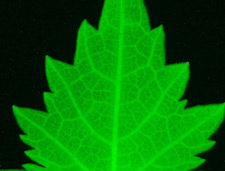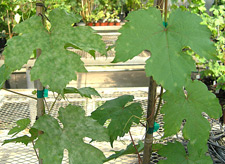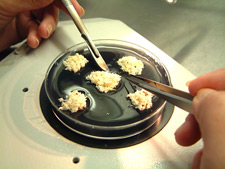Would you drink fluorescent green wine? Most molecular biologists-in-training experience their first taste of genetic engineering by transferring a jellyfish gene into (harmless) Escherichia coli, making the bacteria glow green under UV light. One slow day this past winter, my lab-mates and I contemplated the ramifications of transferring that same gene into Vitis vinifera. Fluorescent green wine? Fluorescent green wine! Oh, wait a minute. Do we seriously want such a thing? And has someone already done it?
Glowing grapevines are already a reality, though it is the leaf, not the grape, that glows, and the plants are a research tool, not a commercial endeavor. Unbeknownst to most of the wine-drinking world, GMO (genetically modified organism) wine—made with grapes grown from grapevines that have had non-native genes inserted into their genomes—is likely to be on shop shelves in the foreseeable future. This should not be much of a surprise, really. Most of the American corn and soybean crops are already genetically modified. In the US, food products containing GMOs need not even be labeled as such. The question is: will the uncommonly traditional and restrictive wine industry accept GMOs with the same aplomb as other food industries have?
Dr. Dennis Gray, a professor of developmental biology at the University of Florida and father of the glowing grapevine, speculates that industry and consumer acceptance may be the most difficult part of bringing genetically modified wine grapes to market. Dr. Gray and his research group have successfully modified—“transformed”—both wine and table grape varieties with genes that make them more resistant to problem fungi and pests. Expressing a specific gene from chardonnay in a Thompson Seedless variety, for example, dramatically improves its resistance to fungal diseases like powdery mildew or sour-bunch rot. The group has had success with a variety of Vitis species, including popular vinifera. The work is motivated in part by the goal of profitably growing grapes in Florida, an endeavor historically plagued by unmanageable Pierce’s Disease, but Dr. Gray sees benefits for growers of both wine and table grapes everywhere.
Gray’s group works with a technique called cisgenetic engineering, which means that they engineer grape plants with genes from grapes rather than, say, genes from corn or bacteria or jellyfish (save for those research-only green-glowing vines, that is.) Not only can specific genes be transplanted from one grape variety to another, expression levels can be boosted for genes that might ordinarily be active only part of the time or at low levels. In contrast to traditional breeding, this means that specific traits can be selected without impacting other desirable characteristics (in theory, at least), and the work can be done much faster than traditional breeding, too.

Will the fact that only grape genes are being used make a difference to opponents of genetic modification? Maybe, but it is not likely to pacify everyone. Both the Australian wine industry and the California-based Wine Institute have issued public statements against the use of any genetically modified organisms, which would include Dr. Gray’s cisgenetic vines. Other researchers are also working on GMO grapes, and some have received clear indications that their work isn’t welcome. Just last August, members of an activist group called “The Voluntary Reapers” ravaged an experimental GMO vineyard in Colmar, France. The vineyard, capstone to a French National Institute for Agronomic Research (INRA) project to engineer grapevine fanleaf virus-resistant vines, was utterly destroyed. The same vineyard was attacked and damaged, to a lesser extent, in November of 2009. Genetic engineering experiments on grapevines by the INRA had been authorized for five years, ending in 2010, and it appears that the Institute has not pursued an extension.
Beyond grapes, yeasts and bacteria used in winemaking are potentially subject to genetic modification, too. One genetically modified yeast, ML01, has already hit the market courtesy of Dr. Hennie van Vuuren at the University of British Columbia and via distributer American Tartaric. Approved for use in the US, Canada, Moldova, and South Africa, ML01 harbors two bacterial genes that enable it to perform malolactic fermentation. Ergo, this nifty little yeast can drive both alcoholic and malolactic fermentation simultaneously, shortening processing time and eliminating the need for a separate malolactic culture. For winemakers, it means less time and less expense. For consumers, ML01 promises to reduce levels of biogenic amines, a prime suspect implicated in the dreaded “wine headache” (for more detail, see Tom Mansell’s great piece here.) Because bacteria used for malolactic fermentation are a potential source of biogenic amines, eliminating the need for bacteria may be helpful. Anything that shortens processing time, too, shortens the window of opportunity for spoilage by organisms that can also elaborate biogenic amines.
Some people are less likely to have hissy-fits over GMO microorganisms versus GMO plants, but the principles at work are the same, and there are some concerns over ML01 and its future kin. The widespread use of commercial active dry yeast already means that the makeup of yeast strains found hanging around in wineries is changing; once a yeast strain is introduced, it is likely to take up residence and become part of the microflora of the winery. GMO yeast with hyper-competitive reproductive and survival abilities could, in theory, make native (i.e. non-commercial) yeast strains endangered species.
Is this a problem? Anyone with a general interest in preserving biodiversity has to answer with an emphatic “Yes, it is.” We often don’t know what we’ve lost until we’ve lost it, and more often than not, we don’t ever know what we’ve lost at all.
Microbiologists, let alone the average consumer, may not even know if or how close that danger lies. Even though ML01 has been around since 2003, its use is shrouded in a fair bit of secrecy. No winery advertises that they use it, and its distributor won’t discuss its client list. Wineries’ fear of backlash—from consumers, or fellow wineries, or both?—apparently outweighs the potential marketing benefits of advertising that a particular wine may cause fewer headaches. Then again, calling attention to that feature in one wine might induce a customer to think that other wines from the same producers that don’t bear the same claim are more likely to cause headaches. This brings up an interesting problem, i.e., that it is difficult for an objective third party to collect field data on how much ML01 reduces biogenic amine levels in practical use. Another interesting point is that the eight year-old ML01 is still the sole genetically engineered yeast approved for enological use. Is this for lack of demand? Technical issues? Or out of fear that “they” do not want GMOs in wine?
Perhaps the most interesting question, at least from a philosophical point of view, is how GMO wine—grapes or yeast—fits into the current enological dynamic. On the one hand, interest in sustainable, biodynamic, organic, green, and/or low-intervention winemaking seems to be at an all-time high. On the other hand, research and technology from ivory towers like UC Davis are constantly making it easier to produce a good, clean, flaw-free product. GMO wine, clearly a product of the second trend, would seem to contradict the first. I, for one, (and perhaps I am excessively scrupulous) would have trouble calling wine that incorporated engineered grapes or yeast a “natural” product. Conversely, however, GMOs could enable winemakers to use fewer chemicals both in the vineyard and in the winery. Dr. Gray’s mildew-resistant grapes could translate to less spraying. ML01 could reduce spoilage and, therefore, potentially reduce manipulations intended to prevent or redress spoilage problems. Ways to reduce chemical use inevitably make the green/biodynamic/sustainable crowd happy.
The winemaking and wine-drinking communities are not facing these questions yet, but it will not be long. Genetically engineered wine grapes already exist and production needs only be ramped up to a commercially-viable scale. The two major hurdles to be crossed before GMO grapes hit the US market are scaling production up to a commercially-viable scale and approval by the FDA. At that point, of course, it is up to individual vignerons whether or not they wish to grow GMO vines. But is this a decision that wine drinkers should be permitted to make for themselves, too? In the US, foods containing GMO ingredients need not be labeled as such, but products that eschew them can voluntarily boast “No GMOs” Should wine be treated in the same way as any other food product? How many consumers would show preference for a wine certified GMO-free?
Green-glowing wine might have a small market amongst the indie-wine-drinking-raver crowd, but I doubt it would ever take off. What do you think?
 Erika Szymanski was blessed with parents who taught her that wine was part of a good meal, who believed that well-behaved children belonged in tasting rooms with their parents, and who had way too many books. Averting a mid-life crisis in advance, she recently returned to her native Pacific Northwest to study for a PhD in microbial enology at Washington State University. Her goal, apart from someday having goats, is melding a winery job to research on how to improve the success rate of spontaneous ferments. When tending her Brettanomyces leaves enough time, her blog Wine-o-scope keeps notes on why being a wine geek is fun.
Erika Szymanski was blessed with parents who taught her that wine was part of a good meal, who believed that well-behaved children belonged in tasting rooms with their parents, and who had way too many books. Averting a mid-life crisis in advance, she recently returned to her native Pacific Northwest to study for a PhD in microbial enology at Washington State University. Her goal, apart from someday having goats, is melding a winery job to research on how to improve the success rate of spontaneous ferments. When tending her Brettanomyces leaves enough time, her blog Wine-o-scope keeps notes on why being a wine geek is fun.
